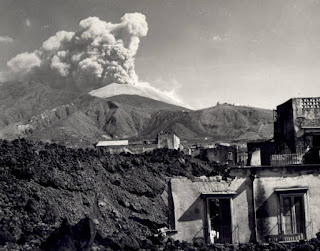The volcano that sometimes blows its top
 |
| The brooding presence of Vesuvius seen across the Bay of Naples from Sorrento |
Vesuvius last erupted in 1944, 72 years ago today, the only volcano on mainland Europe to have erupted during the last 100 years.
It is an easy excursion from Sorrento to visit the volcano, which is enclosed within Mount Vesuvius National Park.
People continue to live on the volcano’s fertile slopes, which have been famous for centuries for producing excellent wine from the grapes grown there. The whole area was officially declared a national park in 1955. The crater of the volcano is accessible to visitors and there is a road to within 200 metres of it, but after that the ascent is on foot only.
The crater is about 200 metres deep and has a maximum diameter of about 600 metres. The climb is said to be well worth it because the view from up there takes in the entire coastline from the Gulf of Gaeta to the Sorrento peninsula.
To get there you can take the train from the Circumvesuviana railway station in Sorrento to Ercolano station, from where a shuttle bus will take you to the park.
There is an observatory, a museum, a visitors centre, a restaurant and a shop where you can buy Lacrima Christi del Vesuvio, the wine made from the grapes grown on the volcano.
But you have to sign up for a guided tour to actually descend into the crater.
Vesuvius is most remembered for its eruption in AD 79, which buried the Roman cities of Pompei and Herculaneum and is believed to have killed thousands of people.
 |
| Vesuvius seen from the village of San Sebastiano al Vesuvio, which was largely destroyed in the 1944 eruption |
There were at least three larger eruptions of Vesuvius before AD 79 and there have been many more since. In 1631 a major eruption buried several villages under lava flows and killed about 300 people and the volcano then continued to erupt every few years after that.
The eruption that started on 18 March 1944 and went on for several days, destroyed three villages nearby and about 80 planes belonging to the US Army Air Forces, which were based at an airfield near Pompei. Some of the American military personnel took photographs of the eruption, which have been useful for today’s experts to analyse.
Since 1944 Vesuvius has been uncharacteristically quiet, although it is constantly monitored for activity and an evacuation plan is in place. Experts believe seismic activity would give them between 14 and 20 days' notice of an impending eruption.
Home
No comments:
Post a Comment